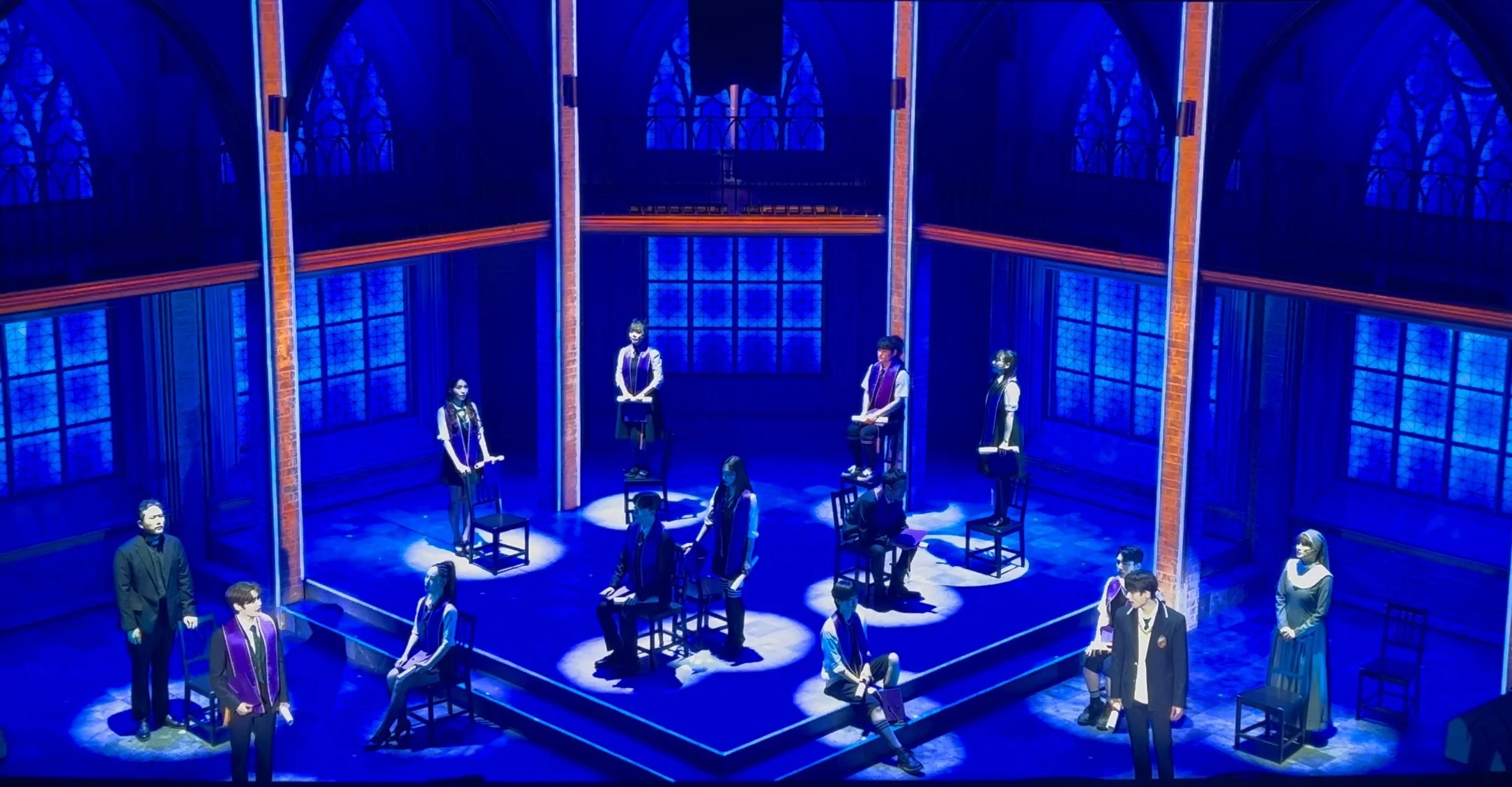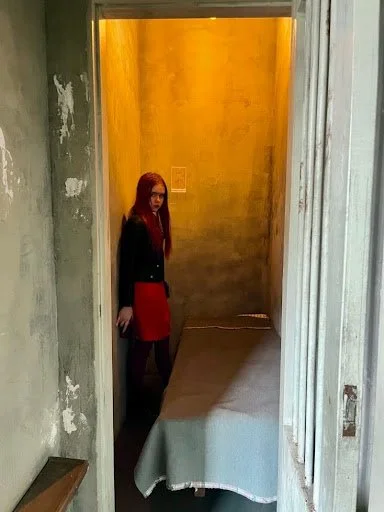Photo courtesy of Anna Goodman ’28
The all-Korean production of “Bare,” an American musical from the early 2000s, inside a performing arts center in the heart of Seoul, South Korea.
By Anna Goodman ’28
Staff Writer
Content warnings: homophobia, transphobia, queerphobia.
(This article uses “queer” extensively as it is how the author identifies; if this makes you uncomfortable, please do not read.)
It’s already past 6 p.m. and I’m standing at an intersection in the middle of Seoul, conspicuously blonde and conspicuously lost, when I admit to myself that this was a terrible idea. I’m searching for a performing arts center, and in it the all-Korean production of a show most people haven’t heard of.
“Bare” is an American musical from the early 2000s, and in many ways, it feels like it. Set at a Catholic boarding school in 1990s America — MHN’s entire queer readership is already wincing — it follows two boys, Jason and Peter, who are secretly lovers, in their final semester before college. It’s moving, it’s heartbreaking, it features a bewildering amount of Bible verses and Shakespeare quotes for a two-hour show, and, like most queer media of its time, its ending is undeniably tragic.
But why go? In an era with hundreds of hours of media at my fingertips that make it a point to emphasize queer joy, why am I sitting in this theater, hoping for a happy ending when I know there won’t be one? Thinking, “maybe it will be different this time?”
Well, the first time I listened to “Bare,” at the ripe old age of twelve, I had been teetering on the edge of telling my parents the truth for at least a year.
“911 Emergency” is a song written so long ago that its main hook is about putting change into a payphone and telling the operator to connect you. But its message — that your parents will love you anyway, and that you deserve to live as who you are — is evergreen. I replayed it more times than I can count. Because, finally, someone understood.
Peter picks up the phone. And so did I.
I soon began wondering if other people also felt this kind of deep, immediate emotional connection when seeing themselves for the first time. So I asked twelve people, six Mount Holyoke students, six not, ranging from ages 15 to 68, to name me queer media that meant something to them as a teenager or young adult.
The difference in their responses — which amounted to 34 separate pieces of media — is telling. The four non-students I asked, aged 36, 40, 53, and 68, took much longer to answer and had far less to choose from. Every one mentioned at least one work with what I’d consider a “tragic” ending, where at least half of the couple dies or where they do not end up together because of societal pressure.
By contrast, my fellow students, and the two other interviewees younger than me could point to any one of a number of shows, movies, musicals, songs, video games, et cetera, that fit their specific experiences. “Red White And Royal Blue.” “Heartstopper.” “Our Flag Means Death.” “Alien Stage.” “She-Ra.”
My mother, who’s roughly the same age as the writers of “Bare,” said, “When I was in high school and most of college [from 1985 - 1992] it was the time of the AIDS crisis … I don’t think the word ‘gay’ was said in any of my high school or college classrooms. If I try to think back I just picture, hazily, a few caricatures on TV and very serious news reports and films about people dying.”
“The queer media representation that came out of the AIDS crisis can be seen as a double-edged sword,” scholar Lillian Joy Myers says in an overview of the changes in queer media. “On one hand, the representation of this time was incredibly powerful and influential … [in describing] how this crisis shook the queer community…[yet] these depictions continued to perpetuate the queer trauma narratives of years past, maintaining a one-dimensional, negative view of queerness and the association between queerness and trauma.”
The effect growing up in this environment has on a queer person can’t be underestimated and is palpable throughout “Bare.” To this day, I come back to Jason’s lines at the end of Act 1 of: “Not all tales have happy endings …‘cause there's no such thing as heroes who are queer”. To this day I wonder how many children still grow up feeling the same way.
The answer: Too many.
But, hopefully, because of media like “Bare,” less.
Speaking to Playbill on the 15th anniversary of the show, “Bare” writer Jon Hartmere said, “I came out while writing ‘Bare.’ I didn't learn I was gay. But I learned it was okay.”
Hartmere’s characters may not have gotten their happy ending. But he helped create a world that meant that he could. He’s now openly gay, and still with his partner of nearly 20 years.
Hilariously, despite all of my preteen angst, neither my parents nor I remember the specifics of when I came out to them. It ended up being so unimportant in the grand scheme of things that the most any of us could remember was that I was probably still twelve.
And, despite the fact that I (thankfully) had what was probably the least eventful coming out in history, “Bare” has held a special place in my heart since. Not only as the capstone of my own journey, but as my reminder not to grow complacent.
In a way, it’s heartwarming that a show made almost thirty years ago can still connect with someone who is lucky enough to have never experienced what its protagonists — or its writers — have.
But it’s heartbreaking too. Because when I watch “Bare,” I don’t just see Peter and Jason. I see the little kids in each of my friends that aren’t quite healed from that feeling of growing up on their own. I see the kids of generations long gone — and far too recent — that never even had the chance to live the lives they wanted.
And then I see my friend Ella, who I often call my ‘honorary little sister.’ When I asked her about what it was like growing up seeing people like her on screen, she said, “Seeing so much casual queer representation at such a young age was amazing for me and my girlfriend … Nothing to make a huge deal about, just something that you are and can be happy with.”
Clearly, we have made progress. We have made change. But I can’t and won’t sit here and argue that we’ve made enough.
In 2024, GLAAD reported that the number of explicitly LGBTQ characters on television was 468, which, while an incredible change from thirty years ago, is still a decrease of over 100 characters since the year before, and less than 1 in 10 characters overall.
When you consider that over 1 in 5 of Gen Z identify as LGBTQ+ today, it’s clear that our media still lacks the numbers that would allow the diversity and humanity really present in our community.
As Myers puts it, in the same piece as above, “Queer characters and storylines are still underrepresented compared to … non-queer plots … Many of them still center white, cisgender, affluent, able-bodied, adult, and/or male characters… [there’s also] the continued use of stereotypes and the prevalence of queer tokenization.”
It's easy, especially for someone like me, to get so swept away in how far we’ve come that we neglect the fact that we still have so far to go. I have two very progressive parents who, despite the time they grew up in, have always made it clear that their acceptance does not come with an asterisk. I go to Mount Holyoke, a very queer-accepting college. I am publishing this in their newspaper. I do not need “Bare” in the same way my twelve year old self did.
But that’s okay, because someone else always does.
Back in Seoul, when I look to my left in the theater, I see something stuck between realization and fear in the eyes of the boy next to me. When I look to my right I see the palpable guilt in the faces of nearly every person old enough to have kids. When I look down at the stage, I see tears on the faces of every performer as the actors who play Peter and Jason hold each other one more time as the curtain closes.
So, I turn to that boy, with fear in his eyes, and we talk. And we keep talking. He’s 15. He walks me home and he complains about his math classes and I gripe about how terrible my Korean is.
I want to ask. I’m scared to ask.
It’s past midnight and I’m standing at an intersection in the middle of Seoul, when this boy tells me, quietly, half through a translator, half through hesitant English, about his best friend. When he stumbles over the words, and he just can’t say it. I hug him. I tell him I understand. That it’s going to be okay.
He’s just a kid. He should be allowed to just…live.
When my parents’ plane lands the next morning, I hug them harder than I have in a long time.
The truth is, I know how the story of “Bare” will end every time it starts, and still, every time, I think to myself: maybe it will be different. Maybe it’ll have a happy ending. And then I realize: Who says it can’t?
My mom grew up in a world that gave her stereotypes and fear; Ella is growing up in a world that gave her “She-Ra.” I’m not naive. I know it’s not easy. It’s a scary world out there, and it’s only getting scarier.
In just a few months, the Trump Administration has rolled back Biden’s protections of LGBTQ+ youth as a whole, made it even harder than it was before for trans youth to access gender-affirming care and surgery, cut federal funding for HIV research and treatment, and issued an executive order stating that that there are only two genders, based on “biological sex.”
They tried to erase us before, and they’re trying again.
But it will be different this time. Maybe not for Jason, or for Peter. But for Ella. For every friend who’s ever called me late at night on the edge of something they don’t understand or told me they were scared to go home. For the boy who hugged me in the middle of Seoul because he had no one else to tell.
For me and for you.
The people who came before us fought tooth and nail for us to be where we are today. And there is no way on this side of the grave that anyone is going to tell my children that “there’s no such thing as heroes who are queer.” Don’t let someone tell yours either. Call your mom. Hug your friends. Tell someone you love them.
Be brave. Be loud. And live.
Karishma Ramkarran ’27 contributed fact-checking.


